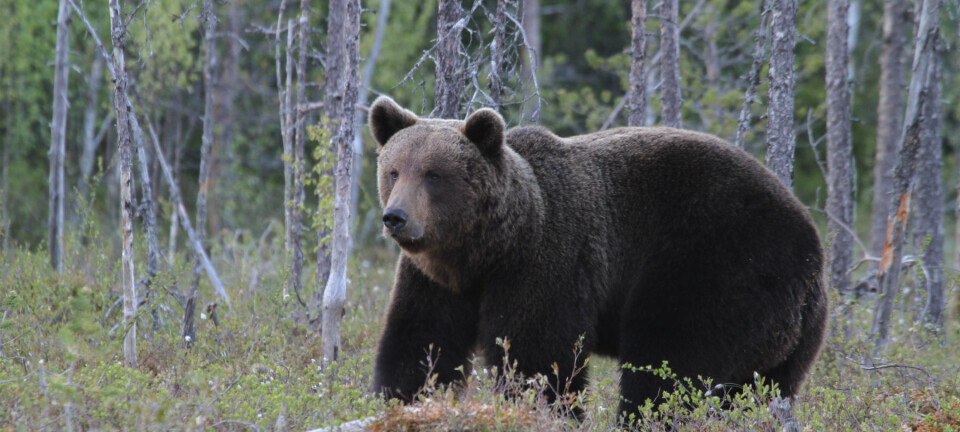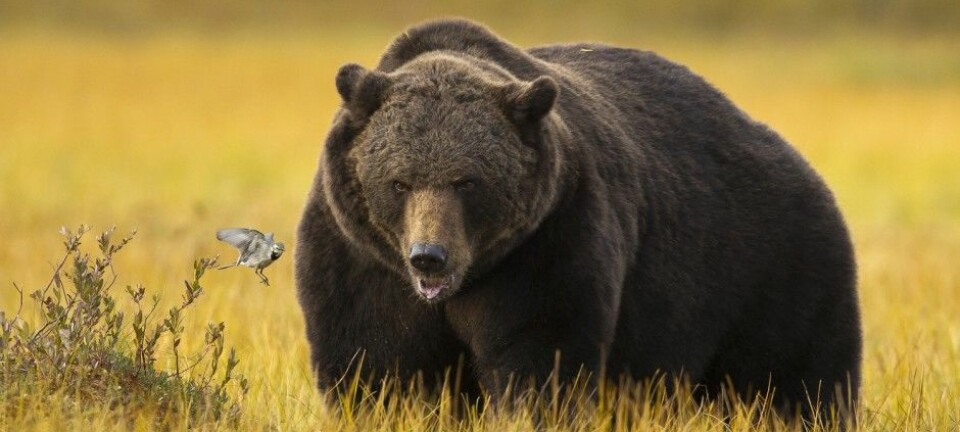
Brown bears vie with wolves for food
When a brown bear crawls out of its den in March it has an intense need for meat. This makes it a direct competitor with wolves, find researchers in several countries.
Brown bears of the Northern Hemisphere feast on much more than honey and berries. A bear is starving when it comes out of hibernation in late March. Living wildlife are high on its menu but they also crave carcasses of livestock or wild animals that other predator species have killed. Moose make for substantial servings and top their list of delights.
Moose do not calve until May. So brown bears try to dine on last year’s moose calves. Only occasionally will they tackle a battle with an adult moose.
Surprising results
Håkan Sand is a researcher at the Swedish University of Agricultural Sciences (SLU). He collaborated with Norwegian, Swedish and American colleagues on a study which yielded some unexpected results.
The scientists found that both the Swedish and North American brown bears are major competitors with wolves for food. This has not been shown before.
Wolves are efficient moose hunters.
In the winter half of the year their diet is composed of about 90–95 percent moose and 70 percent of this consumption consists of moose calves. They continue to munch on moose in the summer season, and calves born in May and June then comprise 90 percent of their diet.
Bears, on the other hand, alter their diet radically once nature wakes up. They nearly become vegetarians but will devour insects too, primarily ants.
Grabbing the meal
An adult brown bear is tougher than a grey wolf. When a bear comes upon the scene of a wolf kill, the hapless Canus lupus has no option but to wait its turn for any leftovers.
“We thought that wolves living in areas with bears would be killing even more moose to compensate for the bears taking over the wolf-killed prey. Surprisingly, it seems that just the opposite happens,” says Sand.
Early in the summer it takes nearly 30 percent longer for wolves to kill their next moose in areas inhabited by bears.
American researchers found the same pattern at Yellowstone National Park in Wyoming.
“When attempting to understand the ecology and the processes occurring with various species it helps to compare them in different parts of the world. When we see the same going on in Sweden and North America it bolsters our belief that this is a general process in nature,” says Sand.
Two possible explanations
The scientists have come up with two explanations why wolves do not kill more moose when bears are competing to feast on moose in the same area.
One possibility is that a bear’s theft of kills prevents wolves from eating in peace and disrupts and delays the wolves in the frequency of their moose kills.
Another explanation is that it is an ordeal to be a moose in areas patrolled by both wolves and bears. This results in fewer calves for wolves to hunt.
Competing with two-legged hunters
Until recently, the wolves and bears of Scandinavia have mostly held sway over separate territories. But in recent years more wolves have turned up in bear regions. This is partly because of an expansion of the Scandinavian wolf stock.
Human hunters will also find fewer moose to shoot in these areas.
“In areas where there are both wolves and bears there will be fewer calves born by each female moose. Naturally this will also impact the numbers shot by hunters,” explains Sand.
Fewer bears in Norway
Sweden has a stock of about 2,500 bears according to WildSweden. Their numbers are diminishing across Sweden’s western border. In 2015 only 128 brown bears were tallied in Norway with the help of DNA analyses of fur and droppings. This is the lowest number registered since a national count was initiated in 2009.
In Norway nearly all female bears have been registered in the border areas with Sweden, Finland and Russia. Young male bears, on the other hand, can wander far and turn up nearly everywhere on mainland Norway, according to the website miljostatus.no.
Not a threat to us
Although the Nordic brown bear will kill animals it is generally not a threat to humans.
This conclusion is partly based on a research project that studied chance meetings between hikers and bears. These occur more often than many hikers might care to imagine. But the bears are aware of us first, while hikers rarely catch a glimpse of them.
Even when the distance between a human and a bear is just 50–100 metres, the person only spots the bear in one instance out of ten, according to Scandinavian research.
-------------------------------------
Read the Norwegian version of this article at forskning.no
Translated by: Glenn Ostling
Scientific links
- Tallian, A. (et.al) Competition between apex predators? Brown bears decrease wolf kill rate on two continents, Proceedings and The Royal Society, 8 February 2017
- Nina Emilie Stenset, et al.: Seasonal and annual variation in the diet of brown bears Ursus arctos in the boreal forest of southcentral Sweden, Wildlife Biology 22: 107–116, 2016








